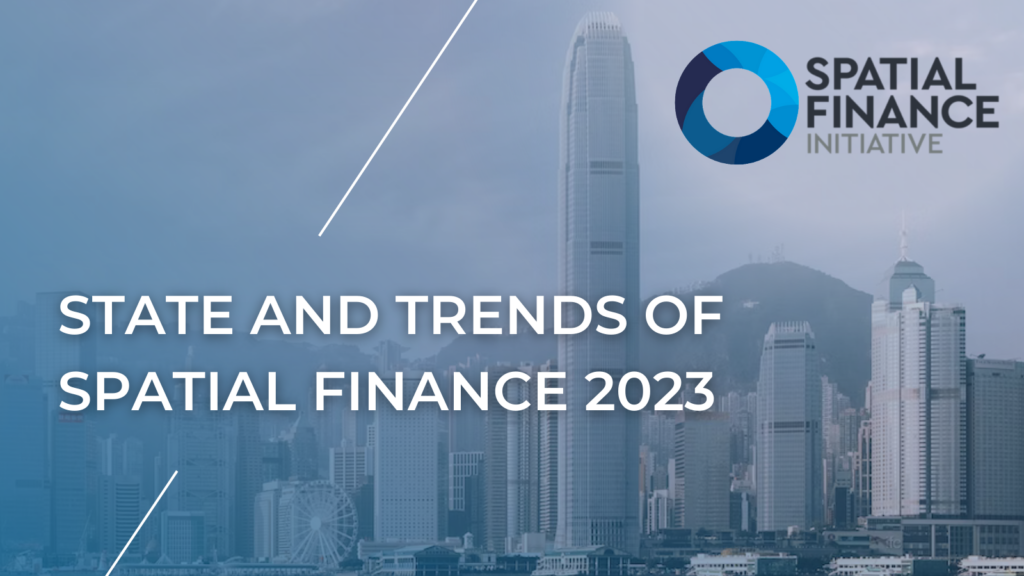New report outlines the latest developments in spatial finance and why geospatial and asset-level datasets are fundamental building blocks for transparency and accountability in green finance .
‘Spatial finance’ is the integration of geospatial data and analysis into financial decision making. Nearly all climate and environmental issues are inherently location specific. Therefore geospatial datasets and technologies can be instrumental in turning green finance theory into practice, to deliver and monitor climate and environmental outcomes in the real economy. At CGFI we believe that spatial or asset-level analysis should be at the core of any robust climate and environmental analytics solution for financial institutions.
Spatial Finance State and Trends 2023
The last 1-2 years have seen significant developments in technological capacities, as well as growing industry engagement with geospatial solutions. The Spatial Finance Initiative’s[1] second report on the state and trends of spatial finance starts by highlighting some of these technical and market developments. Followed by an overview of the state of spatial finance applications and summary of forward-looking trends. Spatial Finance is very much still a nascent and developing area, but three observations stand out.
Policy and partnerships: Financial and geospatial data providers collaborate to anticipate growing demand
Policy and market pressures are driving a geospatial turn in green finance. Disclosures, net zero commitments and verifiable green financial products can all benefit from location-specific information. Financial data and service providers are moving accordingly through acquiring or partnering with specialist climate and geospatial analytics providers. In parallel, innovation by climate fintech start-ups continues to increase, often leveraging new geospatial earth observation data sources or data science techniques.
State of spatial finance: Physical climate risk, carbon offset verification and nature analytics applications gain most traction
As financial institutions are building their capabilities to assess climate risks, complete climate stress tests and make mandatory climate risk disclosures, they draw heavily on spatial analytics solutions for physical climate risk assessments. In voluntary carbon markets, satellite data is increasingly used to monitor, report and verify (MRV) on the integrity of carbon offsets based on nature-based solutions. With nature-related risks and impacts of growing concern for financial institutions, geospatial analysis will become inherent to risk screening and management processes.
Trends of spatial finance: Integrity in green finance claims, embracing complexity and more effective investor engagement will drive demand
Greenwashing scandals and action by regulators will mean better product/client due diligence is needed. As financial institutions are strengthening internal sustainability (data) capabilities they can move away from single sustainability ratings to more granular, issue specific insights. Investor engagement is a powerful tool to drive changes in the ‘real economy’, but its effectiveness to date is increasingly being questioned. With the urgency of climate and environmental issues, engagement processes will have to demonstrate real world outcomes rather than outputs.
Asset data as the fundamental building block for climate and environmental analytics
Asset data is at the core of spatial finance analysis, a building block that links physical assets and their operational characteristics to their exact location and ownership. This allows insights from geospatial environmental datasets – either modelled, or collected from satellites, UAVs and sensors – to be attributed to individual assets, which can then be aggregated at the company, portfolio or country level. However asset data availability, particularly in a format useful for financial decision making, remains a challenge for users and providers alike.
In our GeoAsset project, we develop asset databases for high impact industries which we make openly available for commercial and non-commercial use. We have global and regional datasets available here for the following sectors:
- Cement production facilities
- Iron & steel production facilities
- Beef abattoir facilities
- Petrochemical production facilities
- Pulp and paper production facilities
- Wastewater treatment plants
They have been downloaded for a wide range of applications across research and industry. One case study that is outlined in the report describes two asset data based methodologies, to estimate environmental impacts at the abattoir level in the beef supply chain. It combines asset data with context specific lifecycle analyses, spatial models and observed deforestation data to model upstream scope 3 emissions for beef meatpackers.
CGFI’s vision of bottom-up transparent climate and environmental risk analytics
Our spatial finance work sits at the core of CGFI’s vision of bottom-up climate and environmental analytics for financial institutions. Other CGFI research, tools and initiatives build on our asset databases. For instance, the Global Resilience Index Initiative’s global systemic risk assessment tool combines global open exposure (asset), hazard and vulnerability datasets into a single platform. But also our Sectoral Data Quality and Integrity project that analyses and provides sector-specific insight into the quality of greenhouse gas (GHG) emission data for use by financial institutions. At the same time, we hope these datasets can be used to stimulate commercial innovation and new analytics solutions. Do get in touch if you want to contribute to our mission or learn more!
[1] Part of the UK Centre for Greening Finance and Investment



